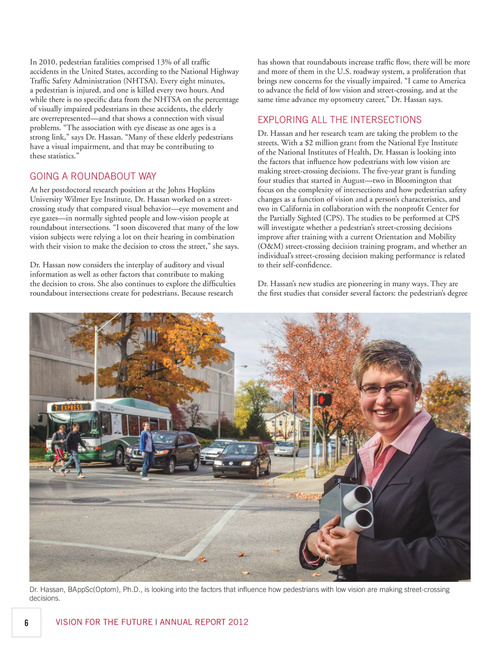
In 2010, pedestrian fatalities comprised 13% of all traffic accidents in the United States, according to the National Highway Traffic Safety Administration (NHTSA). Every eight minutes, a pedestrian is injured, and one is killed every two hours. And while there is no specific data from the NHTSA on the percentage of visually impaired pedestrians in these accidents, the elderly are overrepresented—and that shows a connection with visual problems. “The association with eye disease as one ages is a strong link,” says Dr. Hassan. “Many of these elderly pedestrians have a visual impairment, and that may be contributing to these statistics.”
has shown that roundabouts increase traffic flow, there will be more and more of them in the U.S. roadway system, a proliferation that brings new concerns for the visually impaired. “I came to America to advance the field of low vision and street-crossing, and at the same time advance my optometry career,” Dr. Hassan says.
EXPLORING ALL THE INTERSECTIONS
Dr. Hassan and her research team are taking the problem to the streets. With a $2 million grant from the National Eye Institute of the National Institutes of Health, Dr. Hassan is looking into the factors that influence how pedestrians with low vision are making street-crossing decisions. The five-year grant is funding four studies that started in August—two in Bloomington that focus on the complexity of intersections and how pedestrian safety changes as a function of vision and a person’s characteristics, and two in California in collaboration with the nonprofit Center for the Partially Sighted (CPS). The studies to be performed at CPS will investigate whether a pedestrian’s street-crossing decisions improve after training with a current Orientation and Mobility (O&M) street-crossing decision training program, and whether an individual’s street-crossing decision making performance is related to their self-confidence. Dr. Hassan’s new studies are pioneering in many ways. They are the first studies that consider several factors: the pedestrian’s degree
GOING A ROUNDABOUT WAY
At her postdoctoral research position at the Johns Hopkins University Wilmer Eye Institute, Dr. Hassan worked on a streetcrossing study that compared visual behavior—eye movement and eye gazes—in normally sighted people and low-vision people at roundabout intersections. “I soon discovered that many of the low vision subjects were relying a lot on their hearing in combination with their vision to make the decision to cross the street,” she says. Dr. Hassan now considers the interplay of auditory and visual information as well as other factors that contribute to making the decision to cross. She also continues to explore the difficulties roundabout intersections create for pedestrians. Because research
Dr. Hassan, BAppSc(Optom), Ph.D., is looking into the factors that influence how pedestrians with low vision are making street-crossing decisions.
6
VISION FOR THE FUTURE | ANNUAL REPORT 2012